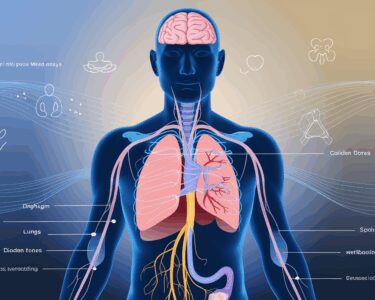How Breathwork Healing Works: Breathwork healing transforms the autonomic nervous system through specific breathing patterns that trigger physiological changes. These patterns activate the vagus nerve and shift the body from stress to relaxation mode. Various breathwork techniques—from Holotropic Breathwork to the Wim Hof Method—create unique healing paths that release deep emotions, lower stress hormones, and improve heart rate variability.
Key Takeaways
- Slow, deep breathing engages the vagus nerve and parasympathetic nervous system, helping shift the body from “fight-or-flight” to “rest-and-digest” mode.
- Regular breathwork practice reduces cortisol levels and increases heart rate variability (HRV), a key indicator of overall health and stress resilience.
- Breathwork serves as an emotional release mechanism, helping to process feelings stored in the body through physical sensations like tingling, spontaneous movements, and tears.
- Different styles like Holotropic Breathwork, Rebirthing, and the Wim Hof Method offer various approaches to healing with specific therapeutic benefits.
- While gentle techniques like diaphragmatic breathing are safe for self-practice, more intensive breathwork methods require professional guidance for optimal results and safety.
The science behind breathwork fascinates me. When you breathe slowly and deeply, your body activates neural pathways that directly calm your nervous system. This isn’t just theory—research shows how breathing patterns change brain activity, heart rhythm, and hormone production almost instantly.
I’ve seen breathwork create profound changes in people who practice regularly. The body stores emotions in physical tension, and controlled breathing helps release this buildup. During sessions, participants often experience spontaneous physical reactions—shaking, crying, or feeling warmth spreading through their bodies—as emotional blocks dissolve.
Choosing the Right Technique
Situational Applications
Different techniques target specific healing needs. Box breathing works great for immediate anxiety relief, while transformational breathwork might help process childhood trauma. Each method creates its own physiological signature and therapeutic outcome.
The Science Behind Your Body’s Stress Response to Breathing
How Breathwork Healing Works Through Your Nervous System
I’ve found that understanding how breathwork healing works starts with your autonomic nervous system (ANS). This incredible system acts like your body’s automatic control center, managing the delicate dance between your ‘fight-or-flight’ and ‘rest-and-digest’ responses. Just like cold therapy can reset your nervous system, specific breathing patterns can trigger profound physiological changes.
When you breathe slowly and deeply, you’re actually tapping into your vagus nerve – the superhighway of your parasympathetic nervous system. This explains how breathwork healing works to shift your body from stress to relaxation mode, similar to how sound therapy calms your mind.
The Measurable Impact of How Breathwork Healing Works
Let’s break down the concrete ways breathwork affects your body:
- Resonance frequency breathing (6 breaths per minute) boosts heart rate variability (HRV)
- Diaphragmatic breathing directly stimulates your vagus nerve
- Regular practice reduces cortisol, your main stress hormone
- Your heart rate noticeably slows during calming breath sessions
I’ve discovered that combining breathwork with other wellness practices, like daily affirmations, can amplify its benefits. The science is clear – when you understand how breathwork healing works, you can use it strategically to improve your stress response.
Your diaphragm plays a crucial role in this process. By engaging this powerful muscle through proper breathing techniques, you’re creating a direct line of communication with your nervous system. It’s fascinating how this connects to other aspects of health – even what you eat can affect your breathing patterns and overall well-being.
The increasing recognition of HRV as a key health indicator proves what ancient breathing practices have suggested for centuries – how breathwork healing works isn’t just theory, it’s measurable science. Regular practice creates lasting changes in your nervous system’s ability to handle stress and maintain balance.
Your Emotional Journey Through the Breath
Breathing patterns tell a powerful story about our emotional state. I’ve discovered how breathwork healing works through its remarkable ability to unlock deep-seated emotions stored within the body. Think of your breath as a gentle key that opens doors to emotional freedom and healing.
How Breathwork Healing Works Through Emotional Release
Your breathing patterns are directly tied to your emotional landscape. When you’re anxious, your breath becomes quick and shallow, much like cold plunge therapy’s initial shock response. During fear, you might unconsciously hold your breath, creating tension patterns throughout your body.
The beauty of breathwork lies in its simplicity – by changing how you breathe, you can transform how you feel. Here’s what happens during a guided breathwork session:
- The facilitator creates a protected space for emotional exploration
- Specific breathing techniques help quiet the analytical mind
- Physical tension begins to dissolve as breathing deepens
- Emotional release occurs naturally and safely
The Physical and Emotional Connection in Breathwork
Just as sound therapy creates vibrations for healing, breathwork healing works by creating waves of energy through your body. During sessions, you might experience:
- Spontaneous body movements
- Tears flowing freely
- Vocal expressions
- Tingling sensations
- Release of muscle tension
This physical-emotional release often pairs well with powerful affirmation practices to anchor the healing experience. The process shows how breathwork healing works on multiple levels – physical, emotional, and energetic.
I’ve noticed that combining breathwork with mindful eating practices can enhance the overall healing journey. This integrated approach helps process emotions stored in the body while creating new patterns of wellbeing.
By engaging in regular breathwork practice, you’re not just learning how breathwork healing works – you’re actively participating in your emotional transformation. The breath becomes your trusted companion, guiding you through layers of stored emotions and leading you toward deeper self-awareness and healing.

Different Breathwork Styles and How Breathwork Healing Works
Popular Breathwork Methods for Healing and Growth
I’ve found that breathwork healing works through several distinct styles, each offering unique benefits for mental and physical wellbeing. Just like sound therapy can calm your nervous system, different breathing techniques target specific outcomes.
Holotropic Breathwork stands out as an intensive practice using rapid breathing paired with music to shift consciousness. This method often triggers profound emotional releases and insights, making it crucial to work with a certified facilitator.
Rebirthing breathwork uses continuous connected breathing without pauses. I’ve seen this technique help people process deep-seated trauma, similar to how cold exposure therapy builds resilience.
The Wim Hof Method shows how breathwork healing works through a combination of controlled breathing and cold exposure. This approach has gained popularity for its immune-boosting properties and stress-management benefits.
Scientific Approaches to How Breathwork Healing Works
Coherent Breathing maintains a steady 5-6 breaths per minute, optimizing heart rate variability. This technique pairs well with daily affirmation practices for enhanced mental clarity.
Here are some structured breathing techniques that demonstrate how breathwork healing works:
- Box Breathing: Equal-length inhales, holds, and exhales (typically 4-4-4-4 counts)
- Diaphragmatic Breathing: Deep belly breathing engaging the diaphragm fully
- Sudarshan Kriya Yoga (SKY): Rhythmic breathing patterns proven to reduce anxiety
- Coherent Breathing: Slow, balanced breathing for heart rate regulation
The effectiveness of these methods varies by individual, similar to how personalized nutrition affects wellbeing. SKY breathing has shown particularly promising results, with research indicating significant reductions in anxiety symptoms.
I always emphasize that while gentle techniques like diaphragmatic breathing are safe for solo practice, more intense methods like Holotropic Breathwork require professional guidance. The power of these practices lies in their ability to influence both physical and emotional states, making proper instruction essential for optimal results.
Through controlled breathing techniques, the practice of mindfulness can be enhanced by exploring how intentional breathing influences the nervous system and emotional regulation.
Sources:
Journal of Alternative and Complementary Medicine
Frontiers in Psychology
International Journal of Yoga Therapy
Stanislav Grof publications
National Center for Complementary and Integrative Health
James Nestor – Breath: The New Science of a Lost Art







